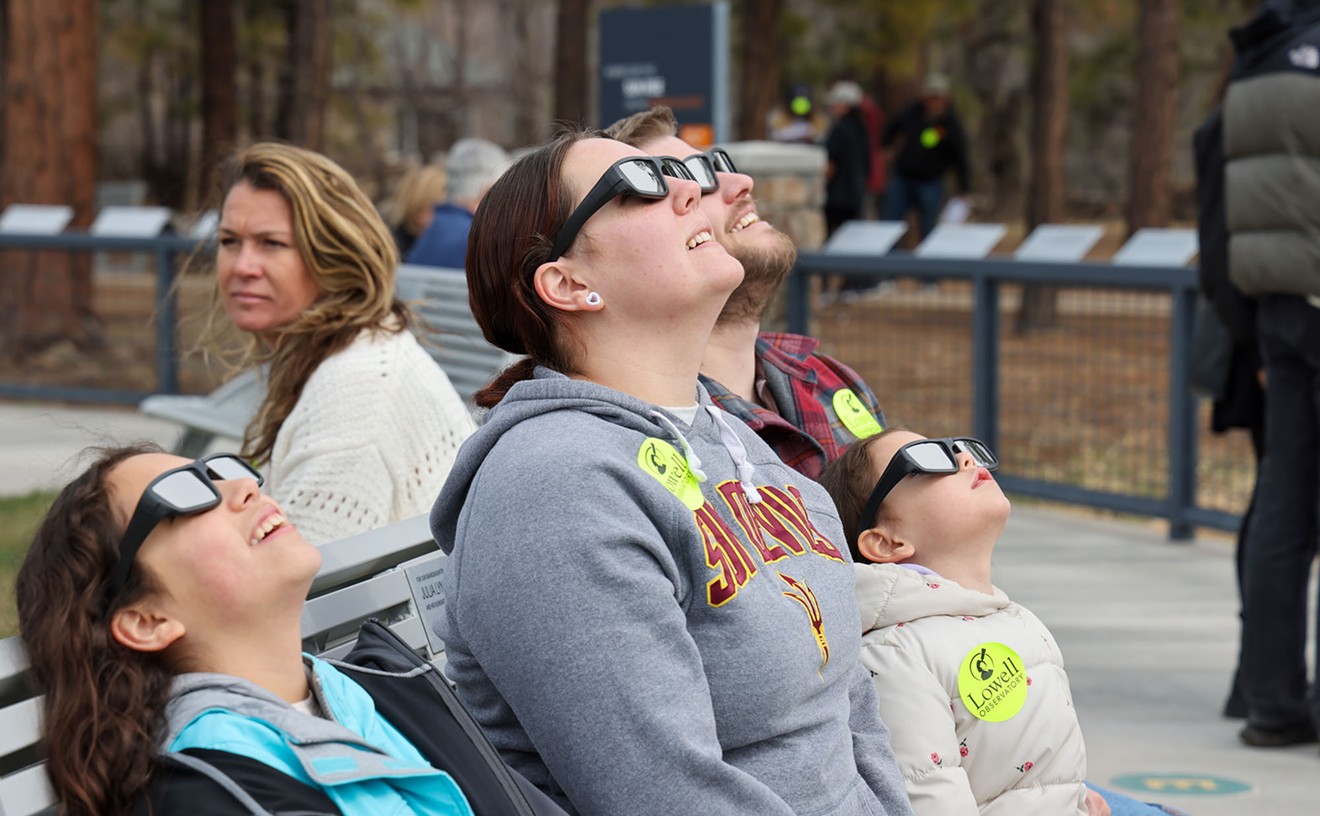But despite all this pretty posing, some neighbors want the birds the hell out of Coronado — an historic 'hood bordered by Thomas Road and I-10, Seventh and 20th streets — and have joined forces to get the feathered fowl rounded up and shipped, later this month, to a bird ranch in Queen Creek. Two peacocks have been caught and dragged away so far because, their detractors say, they are scratching up cars parked on Coronado streets and because their summertime mating calls are loud, annoying, and never-ending.
"They're like giant turkeys," says Stephen Godsey, who owns an apartment complex at 1015 East Palm Lane and was the first to lodge a complaint at City Hall about the big, noisy birds. "They're beautiful, but they don't belong in the city. They have giant claws, and they're scratching up our cars with them. Plus all the screaming they do — like female cats in heat."
Some of the neighbors are pretty catty, too. Those who want the loud, messy peacocks evicted claim the birds are there because one man wants to piss off his neighbors, who hate peacocks. Those who love the birds' noble prettiness are wagging fingers at neighbors who, they say, are mean, animal-hating monsters.
No one is screaming so loudly as the peacocks, though. Perched atop telephone poles, the males bellow for peacock tail well into the night and long before the sun rises each morning.
"I was up 'til three o'clock this morning because of the howling," says Cara Kelly, who's lived in Coronado for a year. "Imagine a rooster as big as a dog, hollering at the top of its lungs all night long . . . If the peacocks are not gone by the time my lease is up, I'm moving."
All that bellowing, everyone agrees, is at the root of the problem in Coronado. But Joe Murphy, an aide to the neighborhood's councilman, Michael Nowakowski, thinks the birds should stay. Murphy's become the reluctant go-to guy on the peacock mess, in part because he used to live in the neighborhood and is sympathetic to the plight of the birds. He thinks the simplest solution to the Coronado cacophony would be to neuter the peacocks so they'll stop hollering for sex.
De-sexing birds sounded peculiar to me, but what do I know about fowl? I called my friend Virginia Kennaway, a veterinarian who's taken care of my cats for years, and asked whether birds got vasectomies. She was polite.
"You can do it, but it's dangerous and expensive," Virginia said. "Fixing the peacocks is sort of a crazy idea, and they'd still scream their heads off. What the neighbors need to do is relocate the birds to a safer place."
Murphy, like many Coronado denizens, disagrees. The peacock presence, he says, "brings real character to the Coronado community."
But Coronado has more than its share of characters already. I know because I lived there for nearly a decade, in the '80s and early '90s. And while I don't remember ever seeing so much as a peacock feather, I do remember The Palm Tree Guy. His name is Wayne Murray, and he still lives in Coronado. In the '80s, he seemed to own about half the neighborhood rentals and had planted every one of his lots with what seemed like hundreds of date palms. Pretty much everyone I spoke to about the peacocks mentioned Murray as a major player in the peacock saga, and I began to wonder if maybe he hadn't traded peacocks for palm trees as his new obsession.
I called Wayne, whom I met one sunny day in 1986 when I came home to find him in my front yard, digging up one of the palm trees growing there. ("Your landlady told me I could have this," he'd said, pointing to the smallish date palm sprouting in a southern exposure of my corner lot.)
I didn't ask Wayne if he remembered meeting me, but I did ask if he was responsible for the peacocks overrunning his neighborhood. He just laughed.
"The birds were abandoned by a woman who lived in Coronado 15 years ago," Murray says. "Two or three of them showed up at my house a few years ago, and I started feeding them. There are five or six of us who feed them. They're scavengers, and they go where they're fed. I'm glad they're here, but I'm not breeding them. And I'm not the reason they're here."
"He's lying, of course," says Jeani Garrett, a wildlife rehabilitator who rescues birds all over the Valley. Garrett believes that Murray is not only breeding the birds but using them to "yank the chain" of next-door neighbor Godsey, because he's a landlord competing for Murray's tenants. Godsey says he represents "14 or 15 householders affected by the peacocks," none of whom will go on the record with their comments "for fear of retribution."
"It's like living in a giant bird cage," Godsey says. "Wayne Murray goes up and down the block feeding those birds so they'll stay. Anyone who isn't bothered by this hasn't had peacock droppings all over their sidewalk. And their front porch chairs!"
Peacock shit, Godsey says, is 20 times larger than pigeon droppings. "They're pretty, but they're not clean animals," he says, adding that Nowakowski "has a file a foot thick with complaints about this mess, but he ignores it."
Not so, swears Murphy, who says that only two people have lodged complaints with the city. Still, word has gotten out about the noisy, car-scratching birds. Garrett, who averages about a hundred peacock calls per year and wants to see the Coronado birds adopted out to ranch owners in Heber and Show Low, says her volunteers are reluctant to rescue peacocks from Coronado because the residents there are so contentious.
"They're not a very helpful bunch," she says. "Peacocks are hard to catch, and usually we need to leave a baited trap that residents can manage until the birds are caught. But the Coronado people seem to want us to come stake out the neighborhood until we catch all the birds."
Garrett wants the peacocks out of Coronado as much as some residents do, because she's convinced the neighbors are taking out their anger at one another on the birds.
She's right. "I like to think of myself as a good person," Kelly says, "but I've contemplated poisoning the peacocks. I've sat outside with my neighbors until three in the morning, shooting at the peacocks with slingshots. The peacocks have ruined my life. There's no reason for them to be here."
Wayne Murray can think of one: the neighborhood kids. They love the big, pretty birds, who leave gorgeous green-and-purple feathers all over during peacock molting season. For Murray, the peacock shrieks are all but drowned out by the joyous yells from little kids who've found a peacock feather on the sidewalk.
"The peacocks are an inner-city blessing," Murray says. "They should never be made to go away."










